The following is a news release by the U.S. Department of Energy to announce proposed efficiency standards for lighting. The release was issued to clear up any potential confusion.
The Department of Energy (DOE) proposed an efficiency standard for General Service Lamps, better known as light bulbs. These issues are complicated, and there has been confusion about DOE’s work to ensure Americans have affordable and efficient lighting technology, so it’s worth understanding exactly what is happening and how we got here.
HOW DID DOE DEVELOP THE PROPOSAL, AND WHAT IS A PROPOSED RULEMAKING?
This proposal is the next step in a legally required public process that started more than two years ago. DOE’s leading experts in lighting and energy efficiency at our National Labs conducted months of research and analysis to understand the efficiency, affordability and reliability of today’s lighting technologies. That analysis was used to inform the proposed rule that was released. Over the next 60 days, DOE will gather input from the public, stakeholders and industry. DOE expects to issue a final rule by January 1, 2017.
Rulemaking is the policy-making process that results in new regulations. Like other federal agencies, the DOE researches issues and conducts extensive analyses in order to develop a proposed rule. The proposal and the results of the research and analysis are made available for public comment by publishing a Notice of Proposed Rulemaking in the Federal Register.
WHY IS DOE ISSUING EFFICIENCY STANDARDS FOR LIGHT BULBS?
DOE is mandated by Congress to set efficiency standards for more than 60 appliances and products from residential air conditioners to electric motors to light bulbs.
In 2007, Congress passed the Energy Independence and Security Act (EISA), which set initial efficiency standards for light bulbs. EISA also required DOE to decide whether stricter efficiency standards for light bulbs were needed and, if so, to work with industry and the public to develop these new rules. Finally, EISA specified a minimum efficiency level or “backstop” requirement for light bulbs if DOE fails to complete the rules required by the law.
In recent years, appropriations bills funding DOE have included language actually prohibiting DOE from spending funds to implement or enforce standards for incandescent light bulbs specifically (think a light bulb with a wire filament).
DOE is proposing a new lighting standard that would apply to General Service Lamps, including LED and compact fluorescent lights. This rule would take effect in 2020. These standards would not apply to incandescent bulbs, which will instead need to meet the congressionally mandated backstop also starting in 2020.
HOW WILL THE PROPOSED RULE AFFECT CONSUMER CHOICES?
DOE carefully considers each proposed rule, with considerable input from the public and stakeholders. The proposed rule would set an efficiency level that is not particular to any technology, but which today only LEDs meet. But these rules take a long-term approach, coming into effect in 2020. Manufacturers and consumers have three years from issuance of a final rule to prepare for these new standards and to continue to support cutting edge research in lighting technologies to ensure that there is a wide range of options on the hardware store shelf.
To be clear, the proposal reflects current market trends in lighting technologies. Earlier this month, General Electric announced that it is discontinuing the manufacturing of coiled CFLs for the U.S. market. In their announcement, GE noted the superior performance and dropping prices for LEDs. Ikea has sold only LED lamps in their stores since September 2015. And the National Electrical Manufacturers Association reported that shipments of LED lights jumped 237 percent third quarter of 2015, compared to the same period in 2014.
WHAT WOULD THIS RULE MEAN FOR THE AVERAGE AMERICAN FAMILY?
Higher efficiency means lower utility bills for American families and businesses. LED lights, which will continue to gain popularity in the market, use 80 percent less power than many of today’s bulbs. They also last far longer. That means big savings on energy and maintenance bills.
A mother who installs a LED light when her child is born won’t need to change the bulb until after her kid graduates from college. For every LED light she might use, she’d have to buy 25 incandescents. She would also spend $129 on electricity using a traditional bulb vs. $26 for a comparative LED.
Just a few years ago, a single LED could cost as much as $100. Thanks to major breakthroughs in technology, LED prices continue to plummet, bringing the upfront cost nearly competitive with conventional bulbs. You can now find LED bulbs for under $5 at hardware stores across America.
Beyond significant cost savings for consumers, these efficiency regulations will also significantly reduce greenhouse gas emissions. In 2014 alone, LED installations prevented 7.1 million metric tons of CO2 emissions and saved $1.4 billion in energy costs. As a result of this proposed rule, more than 52 million metric tons of CO2 emissions would be eliminated. That’s equivalent to the annual electricity use of 7.2 million homes. This rule, if finalized as proposed, would also help save families and businesses over $9 billion on utility bills and new bulbs over 30 years of shipments.
A COMMON SENSE APPROACH TO EFFICIENCY
We should be clear about what this announcement is and what it isn’t. The release of the proposed rulemaking is the next step in a congressionally mandated process that provides the general public, industry, and other stakeholders the opportunity to comment. This proposal is a common sense approach to saving consumers money on their utility bills, while reducing greenhouse gas emissions.
